

You Have to See This
Movie!
Nathaniel Kahn’s My
Architect: A Son’s Journey
details his poignant search for his father, Louis. I. Kahn
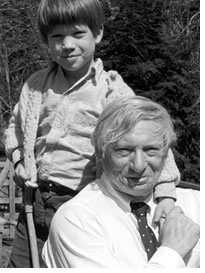 Anyone
with any connection to architecture in the latter half of the last century
knows of Louis I. Kahn: genius and creator of some of the best-known and
most-admired buildings of the time and beloved professor of architecture
at Yale and the University of Pennsylvania. He talked to bricks, and they
answered him truly. An Estonian immigrant whose face and hands had been
scarred by a burning coal when he was a child, he emigrated to America
at the age of three, and grew up to be the husband of Esther and the father
of Sue Ann. Most also know that he died on a return trip from India, alone
in New York’s Penn Station men’s room in 1974, and that his
body lay unclaimed for days. Most don’t know that Kahn had crossed
out the address on his passport, making identification difficult. Why?
Anyone
with any connection to architecture in the latter half of the last century
knows of Louis I. Kahn: genius and creator of some of the best-known and
most-admired buildings of the time and beloved professor of architecture
at Yale and the University of Pennsylvania. He talked to bricks, and they
answered him truly. An Estonian immigrant whose face and hands had been
scarred by a burning coal when he was a child, he emigrated to America
at the age of three, and grew up to be the husband of Esther and the father
of Sue Ann. Most also know that he died on a return trip from India, alone
in New York’s Penn Station men’s room in 1974, and that his
body lay unclaimed for days. Most don’t know that Kahn had crossed
out the address on his passport, making identification difficult. Why?
The unsolved mystery proved a minor adjunct to the larger mysteries of Kahn’s life. He had three families in Philadelphia: besides Esther and Sue Ann, there were Anne Tyng, FAIA, and their daughter, Alexandra Tyng, and Harriet Pattison and their son, Nathaniel, who was 11 when his dad passed away. The three families, all of whom lived within a radius of a few miles, met for the first time at Louis Kahn’s funeral.
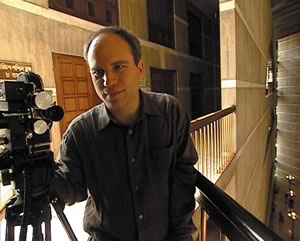 Nathaniel
Kahn recalls his famous father from his once-a-week visits to their home
as well as Nathaniel’s visits to his dad’s office, where his
mother was employed. For a quarter of a century, Nathaniel lived with
fond memories of his dad’s great stories of “silly boats”
(they handmade a little book about them together) and of faraway places,
like India. Then Nathaniel needed more: A filmmaker by profession, he
set out on a five-year odyssey to find the father he barely knew. He did
it through Louis Kahn’s architecture and the people who understood
it—and him—best. The resulting two-hour movie, My
Architect: A Son’s Journey, is nothing short of spellbinding.
Nathaniel
Kahn recalls his famous father from his once-a-week visits to their home
as well as Nathaniel’s visits to his dad’s office, where his
mother was employed. For a quarter of a century, Nathaniel lived with
fond memories of his dad’s great stories of “silly boats”
(they handmade a little book about them together) and of faraway places,
like India. Then Nathaniel needed more: A filmmaker by profession, he
set out on a five-year odyssey to find the father he barely knew. He did
it through Louis Kahn’s architecture and the people who understood
it—and him—best. The resulting two-hour movie, My
Architect: A Son’s Journey, is nothing short of spellbinding.
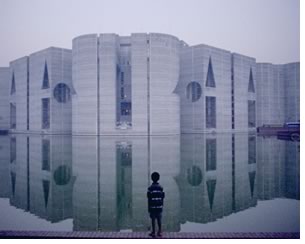 Cast
of characters
Cast
of characters
Nathaniel’s players are a contemporary architecture’s Who’s
Who, from the ever-gracious I. M. Pei to nonagenarian King of Urban
Renewal Edmund Bacon, yelling on a Philadelphia street corner in all his
cantankerous glory. While Pei gently tells Nathaniel, “Three or
four masterpieces are better than 50 or 60 buildings,” Bacon loudly
insists that Kahn pere never really
understood what the overall remake of Philadelphia in the ’60s was
about, and that Kahn fils is just
as dense. Cameos by Philip Johnson, FAIA; Robert A.M Stern, FAIA; and
Frank Gehry, FAIA, add facets to Louis Kahn the Architect, the Genius,
the True Artist. A walk through the desert in Israel with Moshe Safdie,
FAIA, adds incredible depth to the understanding of Louis Kahn as “the
nomad,” which indeed is the name of that particular sequence of
the film.
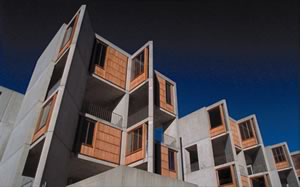 Two
other architects, the mothers of Kahn’s two younger children, bring
important understanding to the film: Anne Tyng, FAIA, and landscape architect
Harriet Pattison, Nathaniel’s mother. That they both became architects
when women architects still were a rarity speaks immediately to their
courage; ditto their single motherhoods. That each worked with Louis Kahn
when they were romantically involved with him speaks of the intermingling
love for the man, the architect, and the architecture. Both Tyng and Pattison
wanted different endings for their love stories, yet both still speak
about Kahn without bitterness.
Two
other architects, the mothers of Kahn’s two younger children, bring
important understanding to the film: Anne Tyng, FAIA, and landscape architect
Harriet Pattison, Nathaniel’s mother. That they both became architects
when women architects still were a rarity speaks immediately to their
courage; ditto their single motherhoods. That each worked with Louis Kahn
when they were romantically involved with him speaks of the intermingling
love for the man, the architect, and the architecture. Both Tyng and Pattison
wanted different endings for their love stories, yet both still speak
about Kahn without bitterness.
 While he could
justify becoming angry, bitter, or permanently “wounded,”
Nathaniel also stays the course of his journey and transcends the hurt
of his largely absent father. He seasons his tale with interviews of non-architects,
bringing the level on which we see Louis a little closer to earth. He
talks to cab drivers who remember shuttling his father from family to
family and around his beloved Philadelphia. Talks with a pair of rabbis
and with his garrulous and WASPy aunts tell some of the anti-Semitism
his father must have encountered with Mainline Philadelphia. And, in a
heart-sinking moment, Nathaniel’s face crashes—quietly—when
a compadre who worked on the Salk Institute casually mentions that Lou
happily spent Christmas at his house with his kids. Nathaniel digests
this while rollerblading the length of the Institute’s famed and
solemn courtyard, skipping across the iconic central water element with
a little more deliberation than necessary. Yet in the end, he embraces
all that his father was.
While he could
justify becoming angry, bitter, or permanently “wounded,”
Nathaniel also stays the course of his journey and transcends the hurt
of his largely absent father. He seasons his tale with interviews of non-architects,
bringing the level on which we see Louis a little closer to earth. He
talks to cab drivers who remember shuttling his father from family to
family and around his beloved Philadelphia. Talks with a pair of rabbis
and with his garrulous and WASPy aunts tell some of the anti-Semitism
his father must have encountered with Mainline Philadelphia. And, in a
heart-sinking moment, Nathaniel’s face crashes—quietly—when
a compadre who worked on the Salk Institute casually mentions that Lou
happily spent Christmas at his house with his kids. Nathaniel digests
this while rollerblading the length of the Institute’s famed and
solemn courtyard, skipping across the iconic central water element with
a little more deliberation than necessary. Yet in the end, he embraces
all that his father was.
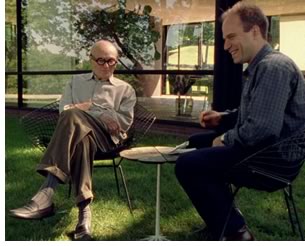 The
real stars of the film are Louis Kahn’s buildings, filmed in sequence
by someone who has come to know intimately and love the powers of stone
and space and light. Interspersed with the interviews, they start with
the Yale Art Gallery, Trenton Bathhouse (which Lou developed with Tyng),
and the Richards Medical Towers. They segue to a Modern building Who’s
Who: the Salk Institute for Biological Studies, Exeter Library,
Yale Center for British Art, and Kimbell Art Museum, each more masterful,
each more honed to the architect’s quest for timeless architecture.
Were My Architect solely a retrospective
of Louis Kahn’s work, it could stand on its own merit as a building
documentary.
The
real stars of the film are Louis Kahn’s buildings, filmed in sequence
by someone who has come to know intimately and love the powers of stone
and space and light. Interspersed with the interviews, they start with
the Yale Art Gallery, Trenton Bathhouse (which Lou developed with Tyng),
and the Richards Medical Towers. They segue to a Modern building Who’s
Who: the Salk Institute for Biological Studies, Exeter Library,
Yale Center for British Art, and Kimbell Art Museum, each more masterful,
each more honed to the architect’s quest for timeless architecture.
Were My Architect solely a retrospective
of Louis Kahn’s work, it could stand on its own merit as a building
documentary.
Redemption
The film is infinitely richer, though, for its layers of people stories.
Although we can rate and debate Louis Kahn the Architect’s oeuvre
until the sacred cows come home, judgment on Louis Kahn the Father remains
the province of Nathaniel and his sisters. It is hard to imagine, however,
any architectural heart not lightened by knowing that in the end Lou is
graced with Nathaniel’s acceptance through understanding of his
buildings. Understanding builds as Nathaniel travels through the Indian
Institute of Management in Ahmedabad (1962–1974) and speaks with
internationally honored architect and teacher B.V. Doshi, who worked with
his father.
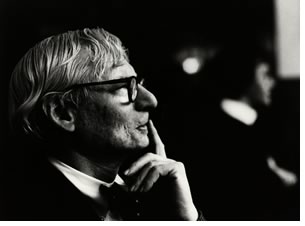 Understanding
culminates at the Capital Complex at Dhaka (1962–1983), Bangladesh,
where native son Shamsul Wares with quiet passion explains to Nathaniel
how Louis, in creating this timeless masterpiece, gave democracy to Bangladeshis
as their government was being born. In the backdrop as silent witness,
light pours through massive concrete cutouts; acceptance dawns with the
light. It was here, not in Philadelphia, that Kahn found his own freedom
to build on the scale of which he previously had only dreamed.
Understanding
culminates at the Capital Complex at Dhaka (1962–1983), Bangladesh,
where native son Shamsul Wares with quiet passion explains to Nathaniel
how Louis, in creating this timeless masterpiece, gave democracy to Bangladeshis
as their government was being born. In the backdrop as silent witness,
light pours through massive concrete cutouts; acceptance dawns with the
light. It was here, not in Philadelphia, that Kahn found his own freedom
to build on the scale of which he previously had only dreamed.
Nathaniel’s film offers a multi-level love story. His search and subsequent acceptance of life’s slings and arrows tell a tale of love of self and one of filial respect beyond the required baseline. Anne Tyng and Harriet Pattison, great adventurers of their time, both lived a romantic alchemy of love for work and genius that perhaps evokes love of creation. And, not least, Nathaniel Kahn proves that filmmakers as well as architects can wield as a tool the love of space and light—timeless and beautifully documented in this extraordinary journey.
Copyright 2004 The American Institute of Architects.
All rights reserved. Home Page ![]()
![]()
 |
||
| The national staff thanks McGraw-Hill Construction for bringing My Architect: A Son’s Journey to AIA headquarters. My Architect was just nominated for an Academy Award for Best Documentary [oscar.com]. Winners will be announced February 29. To learn more about the film, including show locations and times,
visit the My Architect
Web site.
|
||